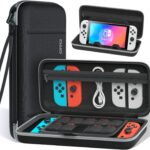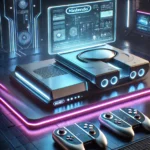1. What You Need (Tools Checklist)
| Item | Notes |
|---|---|
| ✅ HWFLY OLED Modchip | Make sure it’s the OLED version! |
| ✅ Soldering Iron | Fine tip (0.2mm ideally), temp-controlled |
| ✅ Solder | Thin solder (e.g., 0.3mm 60/40 or lead-free if you must) |
| ✅ Flux | Absolutely necessary for clean joints |
| ✅ Microscope or Macro Camera | Helps see tiny points clearly |
| ✅ Kapton Tape | Insulates areas, prevents shorts |
| ✅ Tweezers | Fine point, antistatic |
| ✅ Solder Wick | For correcting mistakes |
| ✅ Thermal Paste | You’ll need this for the reassembly |
| ✅ Tri-Wing Screwdriver + Small Phillips | For opening the Switch |
| ✅ Plastic Pry Tools | Avoids damaging shell |
Optional but super helpful:
- Hot air rework station (to remove shielding cleanly)
- Anti-static mat and wrist strap
2. Preparation Steps Before Touching the Switch
- Fully power off the Switch OLED.
- Remove any MicroSD, game card, Joy-Cons.
- Find a clean, static-free work area.
- Practice soldering tiny wires on a junk board if you’ve never done “microsoldering.”
3. Disassembly Process
✅ Remove back screws (Tri-wing and Phillips).
✅ Take off the backplate carefully.
✅ Remove metal internal shielding (needs unscrewing several more Phillips screws).
✅ Disconnect battery! (very important — no soldering with power connected).
✅ Remove motherboard carefully if needed (some installs don’t need full removal).
Be careful of:
- Delicate ribbon cables (especially for screen, buttons, fan).
4. Installing the HWFLY OLED Chip
✍️ Wiring
- Carefully solder wires from the HWFLY to the motherboard points:
- DAT0 (eMMC line) → Very important!
- CMD (eMMC command)
- CLK (Clock)
- RST (Reset)
- CPU connections (For glitching — usually 2–3 points)
➡️ Some wires go on the top side, some underneath the board.
➡️ Make sure wires are short but not stretched tight.
➡️ Use Kapton tape to keep wires secure and avoid shorts.
✍️ Chip Placement
- Mount the chip in a spot that doesn’t block anything (typically around the shielded areas).
- Use double-sided thermal tape or just secure with Kapton if needed.
5. Reassembly
✅ Carefully reconnect battery.
✅ Reattach shielding and all ribbon cables.
✅ Replace backplate and screws.
6. First Boot (Testing the Chip)
If all soldering is good, when you power on:
- The HWFLY will “glitch” the CPU.
- Your Switch OLED should boot into Hekate (the CFW launcher).
- If it doesn’t boot, the chip usually tries again automatically (you’ll see multiple glitches).
Typical first-time setup:
- Inject payload (Hekate, Atmosphère) via USB-C dongle or manually through chip.
- Setup EmuMMC (so you have an emulated system for hacking, keeping SysNAND clean).
7. Troubleshooting Common Problems
| Problem | Cause | Fix |
|---|---|---|
| Black screen, no boot | Bad solder joints or missing connections | Check under microscope |
| Boots normally into OFW | Chip not glitching, wrong wiring | Recheck solder points |
| Overheating | Forgot thermal paste, bad reassembly | Disassemble and fix |
| Corrupt eMMC | BAD – usually from short circuit | Hope you have backups, may need repair |
8. Post-Install Setup
- Install Atmosphère CFW.
- Set up EmuMMC (keep SysNAND clean!).
- Block Nintendo servers (to avoid bans) using DNS like 90DNS.
- Enjoy homebrew, emulators, custom themes, backups.
🔥 Tips from Experience
- Always, ALWAYS check solder joints under magnification before powering on.
- Keep wires short and neat — sloppy wires cause instability.
- Use plenty of flux — it’s your best friend in microsoldering.
- If unsure, don’t force connectors when reassembling (very easy to break).
🛠️ GOOD RESOURCES
Videos:
- “HWFLY OLED installation step-by-step” (YouTube)
- “Picofly/HWFLY glitch fixing guide”
Communities:
- Reddit r/SwitchPirates
- Discord servers like Switch Hacking Scene (they have help channels)
📢 Final Word
Installing a HWFLY modchip on OLED is an art, not just a task.
It’s totally doable with patience and the right tools, but rushing it is the #1 killer of successful installs.
Practice, take your time, and treat it like surgery.





